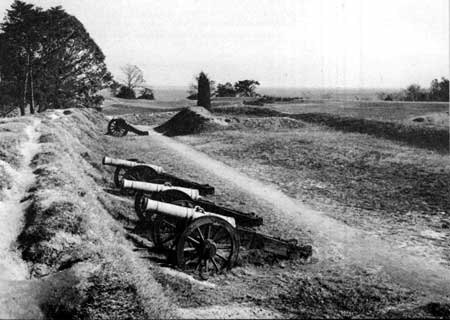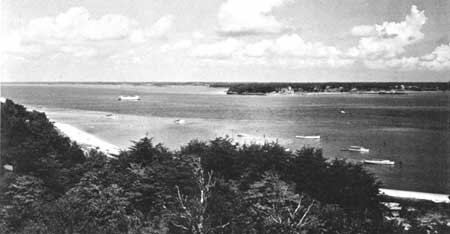|
YORKTOWN National Battlefield |
 |
Siege of Yorktown
(continued)

American Battery No. 2.
OPENING OF THE SIEGE. Washington wrote of the morning of September 30: ". . . we discovered, that the Enemy had evacuated all their Exterior Line of Works, and withdrawn themselves to those near the body of the Town. By this Means we are in possession of very advantageous Grounds, which command, in a very near Advance, almost the whole remaining line of their Defence." Even before Washington had written, American and French units had moved into these works. Within the day, the construction of an additional redoubt and a battery was begun in this sector.
On the morning of the 30th, while these moves were being made on the south side of Yorktown, on the extreme west a French unit from St. Simon's command drove in the British pickets in the vicinity of the Fusiliers Redoubt. A sharp skirmish resulted, with several casualties—an action that enabled the allies to take a more advantageous position in this quarter.
One event only marred the successful moves of the 30th. Col. Alexander Scammell, of New Hampshire, a well-known soldier with much service, was wounded during the early morning while reconnoitering with a small party south of Yorktown. He died from his wound a week later in the base hospital in Williamsburg.
In the first days of October, the allies completed their surveying and planning and pushed the construction and collection of siege material which consisted of gabions (wickerwork-like baskets to be filled with earth to support embankments); fascines (long bundles of sticks of wood bound together for use in filling ditches, strengthening ramparts, etc.); fraises (pointed stakes to be driven into embankments in an upright or inclined position); and saucissons (large fascines). There was some delay while the heavy guns were being transported from the landing points on the James. Perhaps James Thacher penned an accurate short description when he wrote on October 1—2: "Heavy cannon and mortars are continually arriving, and the greatest preparations are made to prosecute the siege in the most effectual manner." By October 6, however, the work of reconnoitering the abandoned British positions south of Yorktown and constructing supporting works there was complete. All was in readiness for the next move—construction of the First Allied Siege Line.

View of Gloucester Point, across the York River
from Yorktown, before construction of the Colemen Memorial
Bridge.
Throughout this interval the British had maintained a steady and effective artillery fire which tended to slow the work of the allies. The journals of the siege are full of accounts, such as that written by Lt. William Feltman on October 2: "A continual cannonading this whole day at our fatigue parties. One Maryland soldier's hand shot off and one militia man killed." Behind the British lines feverish activity continued, and there was fear of a general "alarm." Ships were sunk in the river immediately in front of the town to block any allied landing attempt from that quarter. Cornwallis' positions were not complete, nor were his magazines. Every available man was on the line to help in the construction, particularly the large force of Negro labor which the British general had acquired. To complicate the picture for Cornwallis, smallpox was taking its toll.
GLOUCESTER SIDE. Even though Washington was directing his principal force against Yorktown where the main British force was located, it was necessary that he take measures to contain the enemy post at Gloucester Point on the north side of the river. This would close a possible means of escape for Cornwallis and halt the heavy foraging parties that were sweeping the Gloucester countryside. The first allied force here was 1,500 militia under Brig. Gen. George Weedon. By September 28, Weedon had been reinforced by the Duke de Lauzun's Legion of 600, half of them mounted. Several days later, 800 marines were landed from the French fleet and Brigadier General Choisy was assigned to command the whole. By early October, the British garrison on the Gloucester side had grown and included both Simcoe's and Tarleton's cavalry, as well as ground units.
On October 3, as Choisy moved down toward Gloucester Point to tighten his lines and to force the enemy into their fixed positions on the point, a brief but spirited encounter occurred at "the Hook," near present Hayes Store, in which the daring cavalry leaders, Lauzun and Tarleton, had major roles. Casualties numbered about 16 for the allies and perhaps 50 for the British. The allies succeeded in holding the ground. The British withdrew behind their works where they remained until the end of the siege.

|
|
Last Modified: Mon, Dec 2 2002 10:00:00 am PDT |


